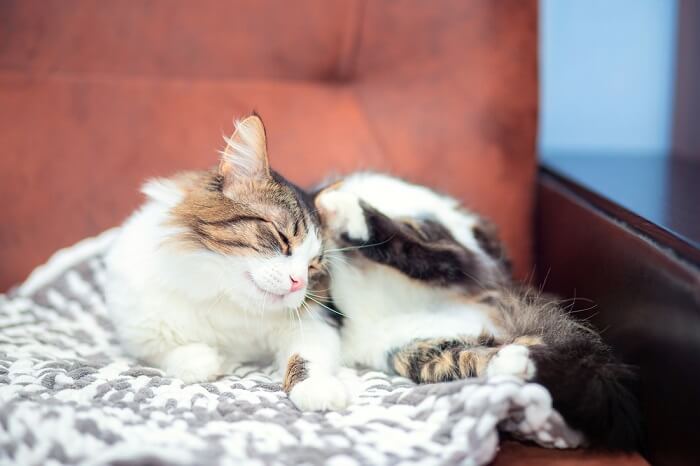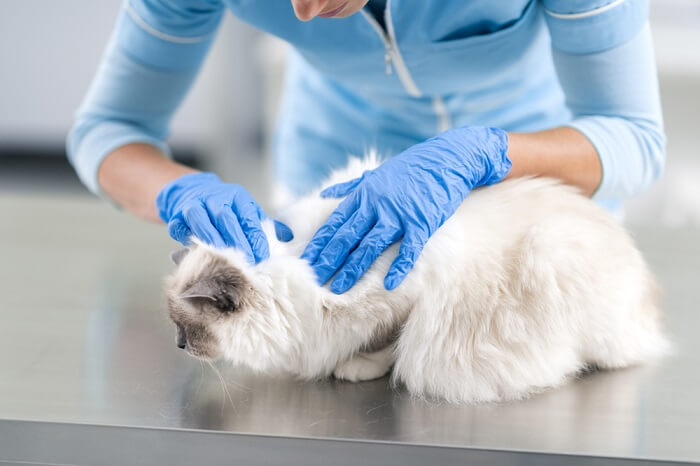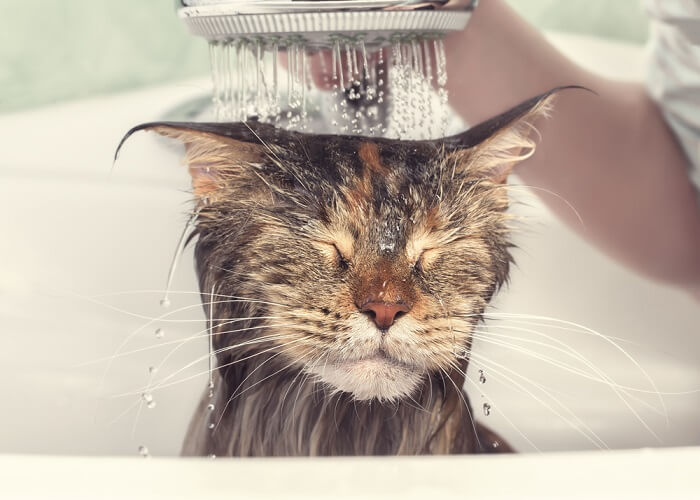
Cat lice affect very few cats in the United States. In addition to the fact that lice are uncommon external parasites, the increased use of topical preventative antiparasitic products has helped to prevent cats from getting them. However, if your cat does happen to get lice, it can be a nuisance to get rid of, obnoxious for your cat, and honestly quite disgusting!
In this article, you’ll learn the details on cat lice, including how cats get them, what they do, and how you can help.
Quick Overview: Cat Lice
 Other Names: Feline pediculosis
Other Names: Feline pediculosis
 Common Symptoms: Itching, biting, chewing of the skin, erratic movements or behavior, signs or irritation, hair loss, dry coat.
Common Symptoms: Itching, biting, chewing of the skin, erratic movements or behavior, signs or irritation, hair loss, dry coat.
 Diagnosis: Lice and eggs (nits) can be visualized directly during an exam.
Diagnosis: Lice and eggs (nits) can be visualized directly during an exam.
 Requires Ongoing Medication: No
Requires Ongoing Medication: No
 Vaccine Available: No
Vaccine Available: No
 Treatment Options: Topical shampoos, sprays, and powders effective at killing lice. Some (but not all) flea/tick preventatives are also effective at killing lice. Body clipping may be helpful to remove all lice and nits from the fur.
Treatment Options: Topical shampoos, sprays, and powders effective at killing lice. Some (but not all) flea/tick preventatives are also effective at killing lice. Body clipping may be helpful to remove all lice and nits from the fur.
 Home Remedies: Disinfecting spaces an affected cat spends time, washing bedding.
Home Remedies: Disinfecting spaces an affected cat spends time, washing bedding.
What Does Cat Lice Look Like?
Cat lice are these teeny-tiny bugs that hang out in your cat’s fur, kinda like little white or yellowish specks, especially around where their fur starts. If you notice your fur buddy scratching like crazy or their skin looks irritated, it might be those little pests causing all the trouble. below is an informative video from Harmony Vet Care for a close-up view of cat lice in your cat’s fur.
What Causes Cat Lice?
The cat louse, Felicola subrostrata, is a biting or chewing louse. It is a tiny crawling insect without wings that lives in the cat’s fur and bites or chews on the skin.
The cat louse is a chewing type of lice and feeds on the cat’s dandruff, oil skin secretions, skin debris, dried blood, and fur. The adult louse is a flat, wingless, six-legged crawling insect that is tan or light brown in color.
These little external parasites have tiny claws that allow them to crawl around in fur and attach to the hair shaft. The females lay their eggs, called nits, in the fur in a glue substance that keeps them firmly attached to the hair and difficult to remove.
Nits look like tiny little white or translucent oval-shaped eggs or flakes. It takes about 21 days for a louse egg to hatch and grow into an adult louse. Lice are tiny insects but still visible to the naked eye. The nits are also visible to the naked eye. This makes them relatively easy to see in the fur.
How Long Do Cats Live?
The lifespan of cat lice, such as Felicola subrostratus, typically ranges from a few weeks to a month. Lice undergo three stages in their life cycle: egg (nit), nymph, and adult. The entire life cycle usually takes about three to four weeks, depending on environmental conditions and other factors.
Lice are host-specific parasites. This means that cat lice only affects cats, dog lice affects dogs, and human lice affect humans. So can cat lice transfer to humans? Lice from one species can get on another species, but it doesn’t stay there, and it typically doesn’t cause itching or other symptoms like it would on its own host.
What Are the Symptoms of Cat Lice?
The most common symptom of cat lice is extreme itching or pruritus. The lice bite and chew the cat’s skin, which is irritating and causes the cat to itch, rub, bite, and scratch itself.
The itching can, in turn, cause hair loss, a scruffy or unkempt haircoat, thin hair, matted hair, broken hairs, and sometimes even cause skin irritation such as scratches, scabs, and general dermatitis as well as a secondary skin infection. Sometimes the infested cat acts anxious or agitated because they are uncomfortable and itchy.
In severe lice infestations, an infected cat or kitten can become anemic. When anemia occurs, it is most often found in a small kitten with a large infestation of lice. The lice bite and chew and can cause blood loss which is more pronounced in a tiny young kitten.
How Do You Diagnose Cat Lice?

To diagnose cat lice, a veterinarian will typically observe the lice moving around on the cat’s skin, collect a louse, and then examine it under a magnifying glass or microscope.
A lice infestation is called pediculosis and is typically diagnosed by a veterinarian on a physical examination. Because lice are small but still visible, the adults can often be seen moving around on the skin when the fur is parted.
The nits are also small but visible to the naked eye and can be seen as tiny white specks at the base of the hair shaft when the hair is parted. Examining with a magnifying glass and good lighting may make them more obvious.
To closely identify a louse, a piece of clear tape can be used to collect it and then it can be examined under a microscope. Another way to collect the lice and nits is to use a fine-tooth comb to gather them and then stick them to the clear tape for closer examination.
A skin scraping might reveal lice as well. Cytology is the process used to diagnosis the cat louse through microscopic examination.
Lice infestations are most often found in cats that live in an unfavorable environment. It is seen more in cats and kittens that are strays, feral, neglected, malnourished, debilitated, sick, dirty, and those kept in unclean overcrowded environments.
How Are Cat Lice Treated?
If you suspect that your cat is infested with cat lice, make sure to take them to see your veterinarian to confirm that lice are the cause of the problem.
Other external parasites such as fleas, mites, as well as other skin conditions such as ringworm can cause similar symptoms.
Your veterinarian will also determine if there is a secondary skin infection or wounds caused by the cat itching and scratching from the lice, that needs to be treated as well.
The first step in treating and getting rid of a lice infestation is trying to remove the lice and nits.
This can be done using a fine-tooth comb to collect as many nits and lice as possible.
Combing alone is not enough to collect the lice and nits, as this method does not remove all of them and it is an extremely tiresome and tedious process, especially in an agitated cat. Bathing in a veterinary-approved antiparasitic shampoo can also help remove some of the lice.
Sometimes, a veterinarian may recommend shaving all or some parts of the cat to aid in removing the lice. Shaving is also beneficial if the cat’s fur is matted.
The next step is applying treatment to kill the lice and prevent the nits from hatching.
The best treatment is a veterinary recommended topical antiparasitic product that is labeled and intended for treating cat lice.

After combing your cat’s coat, you will have to apply an antiparasitic treatment.
These kinds of products include spot-on treatments, sprays, shampoos, dips, and collars. The most effective topical product tends to be a spot-on treatment with parasiticides such as Selamectin, found in Revolution or Revolution Plus, and Fipronil, found in Frontline Plus and Frontline Gold.
Treatment should be continued based on your veterinarian’s recommendations and is typically for several weeks to months to make sure the entire life cycle of the lice is treated.
It is extremely important that you consult with your veterinarian about which products to use to treat the cat lice. Some antiparasitic products are toxic to cats to the point of being deadly.
If the cat also has a skin infection, scratches, or sores, your veterinarian may treat with additional medications or products. These may be oral, injectable, or topical treatments.
Treatment of the environment is an important part of treating and preventing a cat lice infestation.
Make sure all of your cat’s bedding is washed frequently in hot soapy water and treated with the appropriate antiparasitic sprays.
Other items such as collars, clothes, brushes, towels, scratching posts, cat trees, and really anything else your cat has been in contact with, should be cleaned and sanitized. This includes your own bedding and clothes. Vacuum and treat the carpet and furniture often until the infestation is controlled.
Be careful using environmental cleaning and antiparasitic products around your cat as they can be irritating to the eyes, mouth, and respiratory tract. If your house is undergoing professional or DIY treatment, keep your cat away until all products are dry and not able to hurt your cat.
Consult with your exterminator about the products used and the safety around cats.
Make sure to treat all cats in the household or other cats that your cat comes in contact with. Cat lice are extremely contagious between cats.
Preventing Cat Lice
Keep the cat’s environment clean in order to prevent another infestation. It is also important to keep your cat on regular flea and tick preventatives as most of these products will prevent infestations of other topical parasites including lice as well as various types of mites.
Frequently Asked Questions
Can humans get cat lice?
No, humans cannot become infected with cat lice. Lice are species-specific parasites and typically only infect one species. Cat lice infect cats, dog lice infect dogs, and children and people are only infected with human lice.
Where does cat lice come from?
Cat lice is caused by the cat louse, Felicola subrostrata. It is most often found in unfavorable environments such as in dirty and overcrowded conditions and is usually seen in malnourished or otherwise sick cats or kittens. It is often seen in feral or stray cats that have not received flea or tick preventatives and live in these kinds of adverse environments.
How is cat lice spread?
Cat lice is extremely contagious and spreads from cat to cat by close contact or sharing of contaminated items such as bedding or grooming supplies.
How do you know if your cat has lice?
Cat lice is easily seen on the hair coat and looks like small white specks or flakes. The adults can be seen moving in the fur and the nits are stuck to the base of the hair. A close examination of the louse or eggs under a microscope can confirm the identity of the cat louse.
How do you get rid of lice on cats?
Cat lice can be easily prevented by regular application of cat flea and tick products. To treat cat lice, these topical products should be used under the direction of your veterinarian. Other methods of supportive treatment include bathing the cat, shaving if necessary, and treating the environment with insecticide products safe for use around cats.
Do cats get lice from humans?
No, cats typically do not get lice from humans. Lice are highly species-specific, meaning that the types of lice that affect humans are different from those that affect cats.








THANK YOU FOR ALL YOOUR WONDERFUL INFORMATION ABOUT CATS.
IT WAS VERY INFORMATIVE AND I SIGNED UP FOR THE CAT FOOD =S THAT ARE RECALLED. I DO NOT HAVE A FINICKY CAT (THEY ARE NOT BORN FINICKY B UT CREATED BY THEIR OWNERS). SHE EATS fRISKIES PATE TURKEY & GIBLETS DINNER AND LOVES IT.